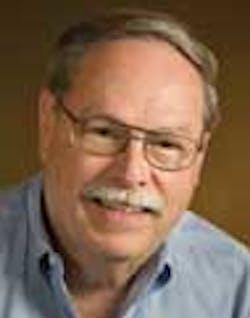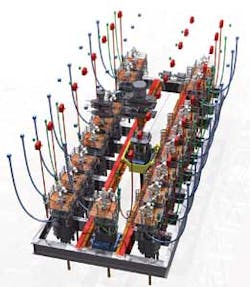Reviewing new technologies from OTC 2013
The 2013 Offshore Technology Conference presented a trove of technology innovations. Besides technology treats sprinkled across the acreage of one of the largest OTC events, there were several off-site attractions that commanded attention.
Halliburton could not transport its new Technology Center to Reliant Park, so it opted to host onsite visits. The center, located at its recently expanded site near Houston's Bush Intercontinental Airport, is the hub of a new approach to research. As explained by Dr. Greg Powers, vice president of technology for the company, "Fundamental research is not specific to a particular product or service line. The work we do here benefits all our divisions worldwide, and we have taken great pains to create a spirit of collaboration that transcends conventional operational groups."
Powers explained that with the new center, Halliburton is able to focus on reducing time-to-production solutions for its clients, not specific hardware or systems. "It has also enabled us to set global standards for all our research labs, regardless of where they are located," Powers added.
The concept has advantages. For example, it allows the concentration of sophisticated testing equipment to maximize the company's return on its R&D investment, which amounted to $460 million in 2012.
Presently, the company is focusing on deepwater, mature fields, and unconventional resource development. An example of the high productivity enabled by the centralized research organization is a materials testing unit that can run thousands of samples per day. "Our workers set up the tests during the day," Powers said. "Then the machines work all night, and when the workers return in the morning, all the tests have been completed. It's a great way to get maximum benefit from our plant and personnel."
A dramatic exhibit demonstrated the evolution of high-performance and high environmental specification integrated microcircuitry that enables tools equipped with these components to operate reliably under sustained environments as high as 230°C (450°F) and more than 30,000 psi.
Powers explained that his lifelong dedication to chemistry is energized by dozens of projects ongoing in the center. He demonstrated this by showing Well Lock, a new organic resin. Well Lock is an epoxy that does not react with water, H2S, CO2, or oil at temperatures as high as 250°F (121°C). It is designed to withstand the extreme stresses and strains of wellbore operations, as the failure limits can be designed in excess of 10k psi and 20% deformation.
Much of the company's focus is on well stimulation services. To address the industry's very real concerns regarding the global shortage of guar, a major component of hydraulic fracturing fluid, the lab has developed PermStim, which substitutes for guar, often at one-third the cost. And a newly introduced Frac Pump, the dual-fuel Q-10, can replace two standard pumps in terms of throughput, delivering 18 bbl/min at 20,000 psi.
Back at OTC
Schlumberger exhibited its Seismic Guided Drilling (SGD) system that can produce a real-time depth migration to continuously update the 3D reservoir model while drilling ahead. With look-ahead capability of as much as 1,500 ft (457 m), the system can do iterative surface seismic depth imaging and anisotropic velocity modeling workflows constrained by real-time drilling and logging-while-drilling (LWD) measurements. The system aims for precise steering to geologic targets while avoiding geohazards.
Enabled by advances in real-time LWD acquisition and large increases in cost-effective computer power, a 3 mi x 3 mi (4.8 km x 4.8 km) block (with the well in the center) can be imaged within the drilling schedule.
The company also revealed its unique NeoScope nuclear LWD system, the industry's first neutron/density logging device that does not require a chemical radioactive source. Answering an industry concern that has lasted decades, the new tool measures a full spectrum of nuclear logging measurements including neutron gamma density, neutron porosity, nuclear elemental spectroscopy, and Sigma. Heretofore, the requirement of chemical radioactive logging sources was a persistent risk that plagued operators. The concern was magnified by the fact that the risk was amplified as wells were drilled to deeper depths in deeper waters, but these were the wells that benefited from the measurements most. The new tool eliminates this risk.
Previous radioactive tools were safe enough when handled by trained logging crews using approved handling tools. The concern came when a tool became stuck in the borehole. Regulations required that attempts be made to fish the tool, which was time-consuming and potentially costly. Special measures were required if the fishing job was unsuccessful. Not only is the new tool sourceless, but it saves rig time previously taken to load and unload the sources from the tool and replace them in their safety shields.
The NeoScope tool is combinable with all of the company's other LWD tools to create a composite logging string capable of performing all petrophysical measurements on a single trip. It is powered by a mud turbine that eliminates the requirement for batteries.
Riserless drilling?
Winner of the OTC Spotlight on Technology Award for the second time, the ReelWell riserless drilling technique has moved closer to its commercial introduction after successful testing in Norway. The technique features a pipe-in-pipe circulation capability completely encased inside the drill pipe. Drilling fluid is pumped down the annulus between the drill pipe and an inner mud conduit. After exiting through conventional bit nozzles, the mud sweeps cuttings from the toolface and sucks them up through ports located just above the bit for transport to the surface through the center conduit. Cuttings transport, often the bane of extended-reach drilling operations, is not a problem because no cuttings are left outside the drillstring to form potential pack-offs.
The system encourages managed pressure drilling operations because well fluid is controlled at all times. If desired, heavy kill mud can be spotted in the borehole annulus for insurance without affecting drilling efficiency. According to the company, when drilling laterals, the system offers a constant pressure from heel to toe, unlike conventional drilling techniques. This adds to the potential lateral length that can be delivered.
A unique feature of the system is a "pushing" force that can be applied by pumping an external piston-like element down the outer annulus. Whereas conventional drillstrings are completely energized by gravity, the ReelWell system can get a boost from the piston to extend its lateral reach. The system claims compatibility with LWD tool strings which provide real-time petrophysical measurements as well as geosteering capability.


